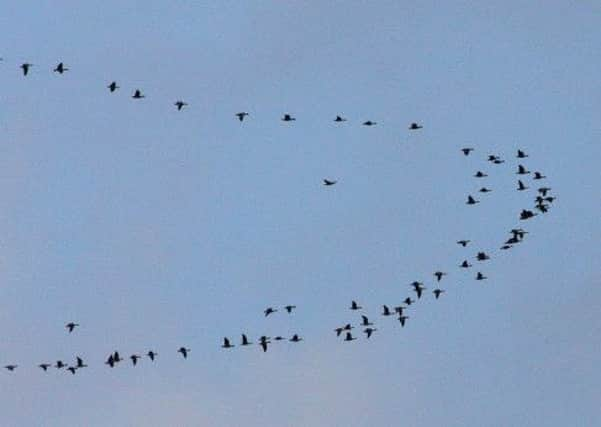Birdwatch: Regimented flights of the migrating pink feet begins


Large numbers of pink-footed geese have been on the move across Yorkshire back to areas where they will spend the winter and many more will be seen, reaching a peak towards the middle of this month.
Last October saw record numbers in Scotland with 78,000 back at the Montrose Basin while in Lancashire there were 45,800 at the Martin Mere reserve, another record. There are also more than 100,000 recorded each winter in north Norfolk.
Advertisement
Hide AdAdvertisement
Hide AdThey spend the winter feeding on the remains of potato and other root crops and are among the most mobile of the wild geese seen here, commuting regularly between sites.
As a result skeins of pink-footed geese, neat, pinkish-brown and with darker brown heads and small pink beaks can be expected at any time making their way from Norfolk across Yorkshire to Lancashire while there is also a small but growing winter population on the Humber estuary.
Exceptional numbers of yellow-browed warblers have continued to arrive along the coast with 22 in the Spurn area on Monday including seven at the Warren and others at Flamborough, Bempton Cliffs, Filey, Scarborough, Long Nab, Burniston and Staithes.
There was a count of 76 on Monday at the Fair Isle observatory off Shetland, more than recorded there in any previous year.
Advertisement
Hide AdAdvertisement
Hide AdSpurn was again the main birding hotspot this week, starting with an Arctic warbler found in a hedge at the Driftwood campsite along with three yellow-browed warblers and seen again the following day. It’s not really an Arctic bird at all but breeds in forests well south of the tundra arriving back as late as the second half of June and leaving again in mid-August to winter in south east Asia.
It is also the only Old World warbler that has colonised North America by establishing a foothold in Alaska.
A male bluethroat, red-breasted flycatchers, two firecrests, a hawfinch and a barred warbler were among other sightings in the Spurn area while a barred and a Blyth’s reed warbler were at Sammy’s Point. A juvenile pallid harrier and hen harrier were also seen over the peninsula.
Flamborough had its first brambling of the autumn and there were more arrivals of redwings, while three common cranes flew down the coast last Friday, circling high over Scarborough and were also reported at Speeton, Kilnsea and Spurn.
Advertisement
Hide AdAdvertisement
Hide AdAn Arctic skua was seen over the Oxenhope watchpoint, and gannets over the Barden Scale watchpoint, Wharfedale, Worsbrough reservoir South Yorkshire and Southfield reservoir, East Yorkshire.
An osprey has lingered for almost a week over the Washburn Valley reservoirs, North Yorkshire, and waders included a pectoral sandpiper at Adwick Washlands and Old Moor reserves in the Dearne Valley, while four jack snipe were seen on the scrapes at Spurn.